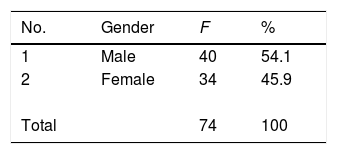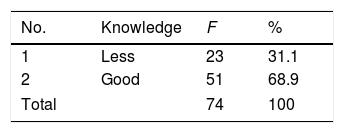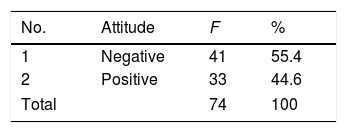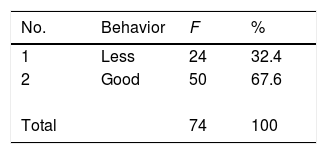Snacks of elementary school students have an important role in fulfill the adequacy of energy and nutrients for the growth and development of children. The objective of this research was to investigate the relationship between level of knowledge and attitude about healthy snacks towards behavior in choosing healthy snacks at the 4th grade and 5th grade students in a public elementary school in Pekanbaru.
MethodThis research used descriptive correlational method with cross sectional approach. The data were collected from 74 samples by distributing questionnaires using simple random sampling technique with the variables were knowledge about healthy snacks and attitude about healthy snacks and choosing healthy snacks behavior.
ResultMost of students have good knowledge (68.9%) and have a negative attitude (55.4%) about healthy snacks and have good behavior (67.6%) in choosing snacks. There was no correlation between knowledge about healthy snacks and the behavior of choosing snacks (p value = 1000) and there was no relationship between attitude about healthy snacks and choosing snack behavior (p value = 0.369).
ConclusionsElementary school teachers always need to control of all types of snacks that are sold in the school.
Food is a source of energy and various nutrients to support human life. But food can also be a vehicle for disturbing human health even can cause death. Healthy food must have nutritional value and be safe for consumed. According to the Minister of Health Regulation No. 033 of 2012, people need to be protected from the dangers of using food additives that do not meet health requirements. Food protection in case is an effort needed to prevent the possibility of contaminated food from biological, chemical and other contaminants that can cause harm and endanger human health. Lack of attention to this matter, has often resulted in the impact of a decline in the health of consumers, such as poisoning due to unhygienic storage and presentation processes.1
One aspect that plays an important role in providing energy and nutrition as well as maintaining learning resistance for children while in school is snacks. For 6–8h/day the time the child spends at school and 90% of school children buy snacks at school. Snack food has good taste on the tongue, easy to get, attractive appearance and affordable price so many children like to buy snacks. However, this is inversely proportional to the quality of snacks, both in terms of the safety of the composition and the cleanliness that can endanger the health of children. The results of the initial survey in Pekanbaru 121 State Elementary School, researchers found a variety of snacks sold by vendors or food vendors of street outside the fence. The results of observations conducted by researchers that many school-age children who snack on food vendors outside the fence, especially during breaks and when they go home from school. Although there is already a healthy canteen at the school and a ban by the school for snacks outside the school fence, there are still many students who remain snacks outside of school.
Based on the background above, the researcher was interested in conducting a research entitled “The Correlation between Knowledge & Attitudes about Healthy Snacks with Behavior in Choosing Food at 4th and 5th Grades in Public Elementary School 121 Pekanbaru”.
ResultsUnivariate analysisCharacteristics of respondentsBased on Table 1 showed that the majority of respondents are male as many as 40 students (54.1%).
Based on Table 2 shows the majority of students’ high school allowance amounts to 40 respondents (54.1%).
Research variablesBased on Table 3 it can be concluded that the majority of respondents have good knowledge about healthy snacks as many as 51 respondents (68.9%).
Based on Table 4 it can be concluded that the majority of respondents have a negative attitude about healthy snacks as many as 41 respondents (55.4%).
Based on Table 5, it can be concluded that the majority of respondents have good behavior in choosing snacks, as many as 50 respondents (67.6%).
Bivariate analysisCorrelation between knowledge about healthy snacks with behavior in choosing foodThe results of chi square statistical tests obtained p value of 1000. The results of this study have a value of α>0.05 so that Ho was accepted, it is concluded that there was no correlation between knowledge about healthy snacks and behavior in choosing food.
Correlation between attitudes about healthy snacks with behavior in choosing foodThe results of this study have a value of α>0.05 so that Ho was accepted, it is concluded that there was no relationship between attitudes about healthy snacks and behavior in choosing food.
DiscussionUnivariate analysisCharacteristics of respondentsIn this study it was found that the most respondents were 40 respondents of male (54.1%) because in each at 4th grade and 5th grade male students were more. According to Utami and Waladan's (2017) research, boys are more active in physical activities and sports, activities that cause boys to need a lot of energy. This energy is obtained by children from snacks purchased at school.3
Characteristics of respondents based on pocket money are known that most of the students are more than Rp. 6000 as many as 40 students (54.1%). The provision of pocket money gives influence to the child to be responsible and learn to manage the pocket money he has. Reasons that cause children to consume snacks more and more often are increasing the provision of snacks.4
Knowledge of healthy snacksThe majority of respondents are well informed about healthy snacks. This can be caused by the knowledge of snacks that have been delivered by the teacher in the elementary school. Children's knowledge can be obtained both internally and externally. Internal knowledge is knowledge that comes from itself based on the child's life experience. Externally knowledge is knowledge gained from other people including family, parents, and teachers. Knowledge gained both internally and externally will increase children's knowledge about healthy snacks.2
Attitudes regarding healthy snacksThe majority of respondents have a negative attitude about healthy snacks. This is because children are affected by friends who have a positive attitude toward snacks. A person's attitude will affect his knowledge. Attitudes can describe the reflection of a person's feelings in the form of positive and negative values on a particular object, where the attitude affects the actions of a person to achieve his goals.7
Behavioral in choosing foodThe majority of respondents have good behavior in choosing food. This can be caused because the child's behavior is not spared from the attitude and knowledge he has. Food habits are part of the behavior in the form of real actions that become a pattern of behavior that tends to be difficult to change. School-age children have the habit of buying food they like. Children have a changing nature of food so that often children choose the wrong snacks especially if not guided by their parents.3
Correlation between knowledge about healthy snacks with behavior in choosing foodBased on the results of the research conducted showed there was no correlation between knowledge about healthy snacks and behavior in choosing food. Good knowledge does not necessarily guarantee that the child behaves well. Many things affect children in behaving. This is due to the child's knowledge factor. In general, the knowledge gained by children is limited to the basic knowledge of the school. Children only get knowledge about the function of food, nutritional elements of food, and washing their hands before eating, while as a result of consuming unhealthy snacks, consuming food that is not safe, does not have sufficient nutritional value, consuming snacks containing preservatives, flavorings excess and artificial sweeteners are not too emphasized, children only think that the snacks they eat can eliminate hunger so that in choosing snacks the child does not pay attention to the nutritional value found in the snack.5
School-age children have a high curiosity, especially in snacks, of course with curious, they always want to try snacks sold in the school environment without regarded to the nutritional content and the dangers of current snacks.6
Correlation between attitudes about healthy snacks with behavior in choosing foodBased on the results of the research, it was shown that there was no correlation between attitudes about healthy snacks and snacking behavior. Child behavior does not escape his attitude and knowledge. The results of research conducted show that the attitude of more negative children behaves well. This is because children who have a negative attitude are influenced by the environment, especially their peers. His attitude is positive in choosing snacks and arises the desire to taste the food eaten by his friend. The behavior that arises is imitating a friend even though it is not in accordance with the attitude he has. This is in accordance with the characteristics of primary school children who like to imitate people around them including parents, teachers and peers.
ConclusionThe level of children's knowledge about healthy snacks, the majority of children have good knowledge that is equal to 68.9%. The child's attitude about healthy snacks, the majority of children have a negative attitude that is equal to 55.4%. As for the behavior of children in choosing food, the majority of children have good behavior which is 67.6%. The results of the chi square statistical test showed that there was no correlation between knowledge about healthy snacks and behavior in choosing food, with the acquisition of 1000 p values. Furthermore, the results of the chi square statistical test showed that there was no relationship between attitudes about healthy snacks and behavior in choosing food with the acquisition of p value 0.369.
The researcher expressed their gratitude to Public Elementary School 121 Pekanbaru who gave permission to the researcher to conduct research and thank the students at 4th and 5th Grades in Public Elementary School 121 Pekanbaru who had been willing to become respondents in this study.
Peer-review of abstract of the article is under the responsibility of the Scientific Committee of Riau International Nursing Conference 2018. Full-text and the content of it is under responsibility of authors of the article.













